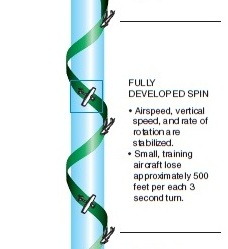
Chapter 4—Slow Flight, Stalls, and Spins
Table of Contents
Introduction
Slow Flight
Flight at Less than Cruise Airspeeds
Flight at Minimum Controllable Airspeed
Stalls
Recognition of Stalls
Fundamentals of Stall Recovery
Use of Ailerons/Rudder in Stall Recovery
Stall Characteristics
Approaches to Stalls (Imminent Stalls)—Power-On or Power-Off
Full Stalls Power-Off
Full Stalls Power-On
Secondary Stall
Accelerated Stalls
Cross-Control Stall
Elevator Trim Stall
Spins
Spin Procedures
Entry Phase
Incipient Phase
Developed Phase
Recovery Phase
Intentional Spins
Weight and Balance Requirements

INCIPIENT PHASE
The incipient phase is from the time the airplane stalls and rotation starts until the spin has fully developed. This change may take up to two turns for most airplanes. Incipient spins that are not allowed to develop into a steady-state spin are the most commonly used in the introduction to spin training and recovery techniques. In this phase, the aerodynamic and inertial forces have not achieved a balance. As the incipient spin develops, the indicated airspeed should be near or below stall airspeed, and the turn-and-slip indicator should indicate the direction of the spin.
The incipient spin recovery procedure should be commenced prior to the completion of 360° of rotation. The pilot should apply full rudder opposite the direction of rotation. If the pilot is not sure of the direction of the spin, check the turn-and-slip indicator; it will show a deflection in the direction of rotation.

Figure 4-10b. Spin-Fully Developed.
PED Publication